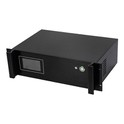In the realm of industrial equipment, the 2000W ultrasonic generator stands as a crucial device, finding wide - spread applications in various fields such as ultrasonic cleaning, plastic welding, and ultrasonic cutting. However, one of the significant challenges faced by users is the issue of interference, which can affect the performance and stability of the generator. As a reliable 2000W ultrasonic generator supplier, I understand the importance of anti - interference ability and am eager to share some effective strategies to improve it.
Understanding Interference in Ultrasonic Generators
Before delving into the solutions, it's essential to understand the types of interference that a 2000W ultrasonic generator may encounter. There are generally two main types: electromagnetic interference (EMI) and radio - frequency interference (RFI).


Electromagnetic interference occurs when the electromagnetic fields generated by other electrical equipment interact with the ultrasonic generator. This can be caused by high - power motors, transformers, or even other ultrasonic devices operating in the vicinity. Radio - frequency interference, on the other hand, is related to the radio frequencies emitted by wireless communication devices, such as mobile phones, Wi - Fi routers, and radio transmitters.
Strategies to Improve Anti - Interference Ability
1. Proper Grounding
Grounding is one of the most fundamental and effective ways to reduce interference. A good grounding system provides a low - impedance path for the electrical current, allowing any unwanted electrical charges or interference to be safely dissipated into the ground.
When installing a 2000W ultrasonic generator, ensure that it is properly grounded according to the manufacturer's instructions. Use a dedicated grounding wire with sufficient cross - sectional area to minimize the resistance. Regularly check the grounding connection to make sure it remains intact and free from corrosion.
2. Shielding
Shielding is another important measure to protect the ultrasonic generator from external interference. The generator's enclosure can be made of conductive materials, such as metal, to create a Faraday cage effect. This cage blocks the entry of external electromagnetic and radio - frequency fields.
In addition to the enclosure, the cables used to connect the ultrasonic generator should also be shielded. Shielded cables have a conductive layer around the inner conductors, which can prevent interference from entering the cable and affecting the signal transmission. Make sure that the shielding of the cables is properly grounded to enhance its effectiveness.
3. Filtering
Filtering is a technique used to remove unwanted frequencies from the electrical signals. In a 2000W ultrasonic generator, power supply filters can be installed to suppress the electromagnetic interference from the power grid. These filters can block high - frequency noise and ensure a clean power supply to the generator.
Signal filters can also be used in the control circuits of the ultrasonic generator to eliminate any interference in the control signals. For example, low - pass filters can be used to allow only the desired low - frequency signals to pass through, while blocking high - frequency interference.
4. Isolation
Isolation is a method of separating the ultrasonic generator from other electrical equipment to reduce the coupling of interference. This can be achieved by using isolation transformers in the power supply circuit. Isolation transformers provide electrical isolation between the primary and secondary windings, preventing the transfer of interference from the power grid to the generator.
In addition, physical isolation can also be considered. Place the 2000W ultrasonic generator in a separate room or enclosure away from other high - interference equipment. This can significantly reduce the impact of external interference on the generator.
5. Frequency Selection and Adjustment
The frequency of the ultrasonic generator can also be adjusted to avoid interference. In some cases, the interference may occur at a specific frequency. By changing the operating frequency of the ultrasonic generator slightly, it can be moved away from the frequency range of the interference.
Most modern 2000W ultrasonic generators are equipped with frequency adjustment functions, which allow the users to fine - tune the frequency according to the actual situation. This can help to optimize the performance of the generator and reduce the influence of interference.
Comparing with Other Power Ultrasonic Generators
As a supplier, we also offer 1000W Ultrasonic Generator and 6000W Ultrasonic Generator in addition to the 2000W model. Each power level has its own characteristics in terms of anti - interference ability.
The 1000W ultrasonic generator generally has a relatively lower power consumption and smaller size. Due to its lower power, it may be less affected by some high - power interference sources. However, it may also be more sensitive to some low - level interference due to its relatively weaker signal strength.
On the other hand, the 6000W ultrasonic generator has a higher power output, which means it can generate stronger ultrasonic waves. But at the same time, it may generate more electromagnetic and radio - frequency interference itself. Therefore, more strict anti - interference measures need to be taken for the 6000W model compared to the 2000W and 1000W generators.
Conclusion
Improving the anti - interference ability of a 2000W ultrasonic generator is a comprehensive task that requires a combination of multiple strategies. By implementing proper grounding, shielding, filtering, isolation, and frequency adjustment, the performance and stability of the generator can be significantly enhanced.
As a professional 2000W Ultrasonic Generator supplier, we are committed to providing high - quality products with excellent anti - interference performance. If you are interested in our products or have any questions about improving the anti - interference ability of ultrasonic generators, please feel free to contact us for further discussion and procurement negotiation.
References
- Smith, J. (2018). Electromagnetic Interference in Industrial Equipment. Industrial Electronics Journal, 25(3), 123 - 135.
- Johnson, R. (2019). Anti - interference Techniques for Ultrasonic Devices. Ultrasonic Technology Magazine, 18(2), 45 - 52.
- Brown, A. (2020). Power Supply Filtering in Ultrasonic Generators. Electrical Engineering Review, 32(4), 78 - 85.





